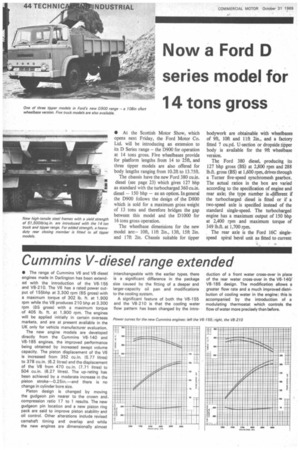Cummins V-diesel range extended
Page 46

If you've noticed an error in this article please click here to report it so we can fix it.
• The range of Cummins V6 and V8 diesel engines made in Darlington has been extended with the introduction of the V6-155 and V8-210. The V6 has a rated power output of 15513hp at 3.300 rpm (BS gross) with a maximum torque of 302 lb. ft. at 1,900 rpm while the V8 produces 210 bhp at 3,300 rpm (BS gross) with a maximum torque of 405 lb. ft. at 1,900 rpm. The engines will be applied initially in certain overseas markets, and are at present available in the UK only for vehicle manufacturer evaluation.
The new engine models are developed directly from the Cummins V6-140 and V8-185 engines, the improved performance being obtained by increased swept volume capacity. The piston displacement of the V6 is increased from 352 cu.in. (5.77 litres) to 378 cu.in. (6.2 litres) and the displacement of the V8 from 470 cu.in. (7.71 litres) to 504 cu.in. (8.27 litres). The up-rating has been achieved by a moderate increase in the piston stroke-0.25in.—and there is no change in cylinder bore size.
Piston design is changed by moving the gudgeon pin nearer to the crown and. compression ratio 17 to 1 results. The new gudgeon pin location and a new piston ring pack are said to improve piston stability and oil control. Other alterations include revised camshaft timing and overlap and while the new engines are dimensionally almost interchangeable with the earlier types, there is a significant difference in the package size caused by the fitting of a deeper and larger-capacity oil pan and modifications to the cooling system.
A significant feature of both the V6-155 and the V8-210 is that the cooling water flow pattern has been changed by the intro
duction of a front water cross-over in place of the rear water cross-over in the V6-140/ V8-185 design. The modification allows a greater flow rate and a much improved distribution of cooling water in the engine: this is accompanied by the introduction of a modulating thermostat which controls the flow of water more precisely than before.


























































































































